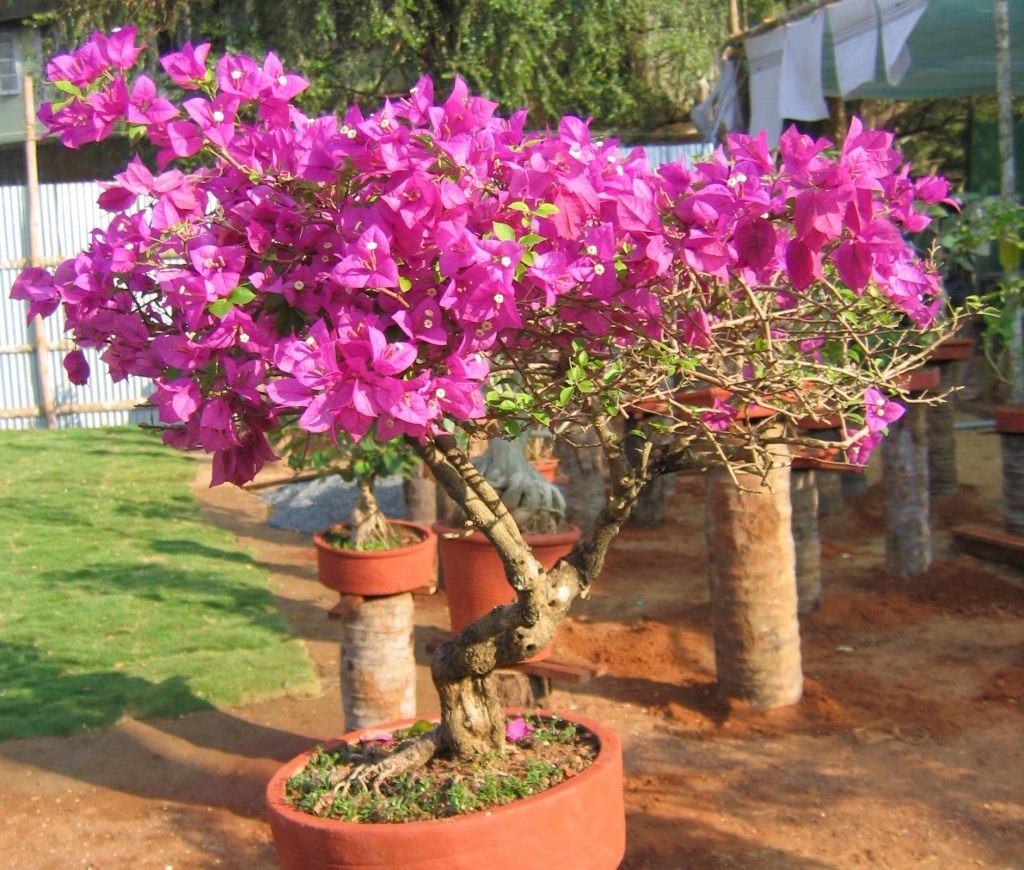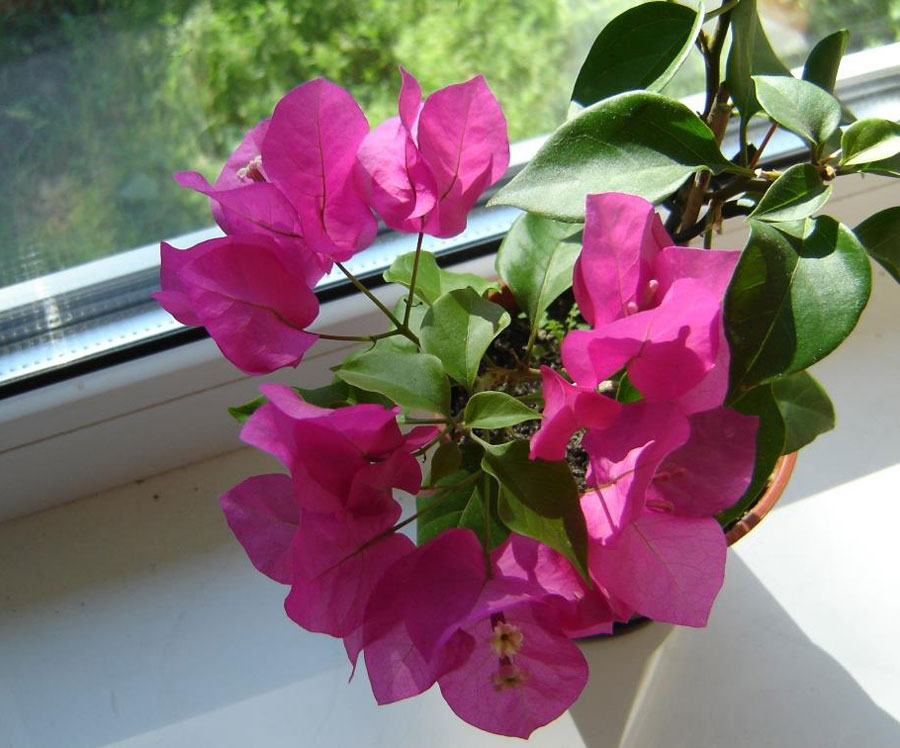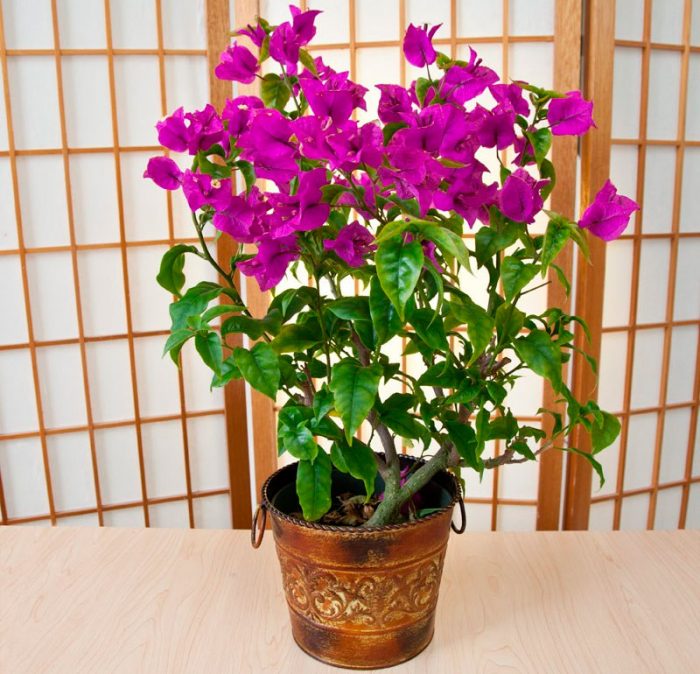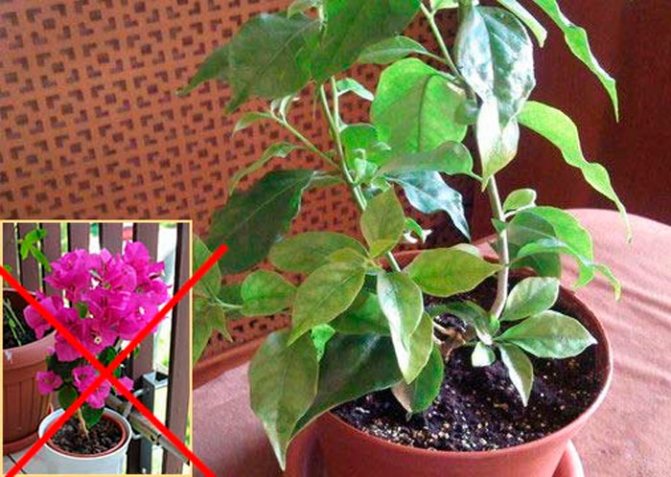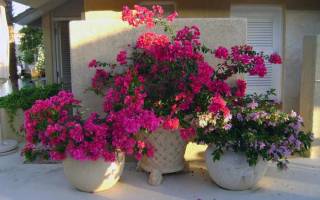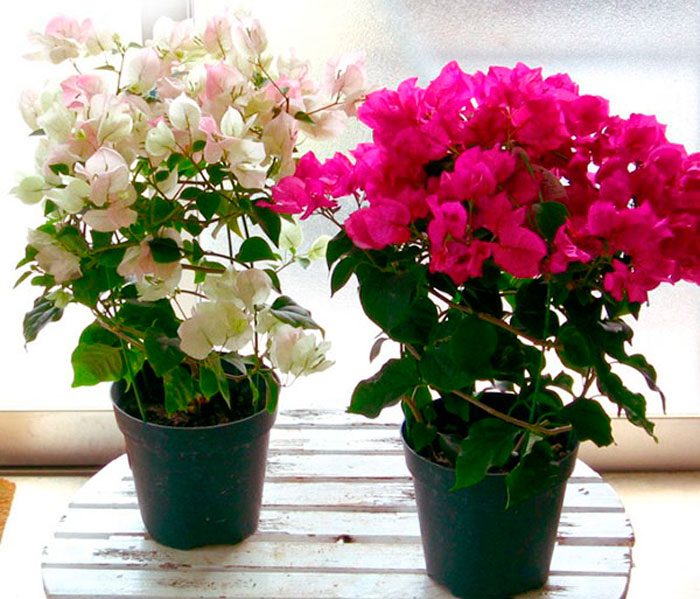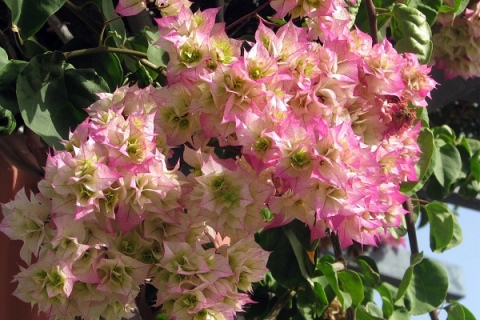Reproduction Bougainvillea
Three different methods are used for reproduction. Let's consider them in order.
By cuttings
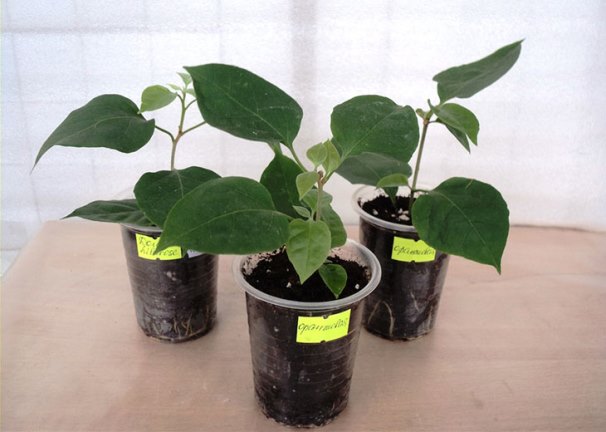
The most popular way to propagate Bougainvillea is by cuttings, because it is the simplest and most successful. Semi-lignified cuttings cut in June are used as planting material. Try to choose cuttings that are not yet flowering, growing in depth or thickening the crown, so as not to spoil the decorative effect of the mother bush. Remove the lower leaves. Bougainvillea should be rooted in a mixture of peat and sand in a container with a lid or in a plastic cup under a film. It is advisable to treat the cuttings with crushed coal and a root formation stimulator (Kornevin, Zircon and others).
The substrate must be moist. Rooting temperature should be 25 - 26 g. The greenhouse is ventilated, if necessary, moistened. Remove the lid after the plant starts growing. It is advisable to use the bottom heating and backlighting, then the rooting guarantee will be higher. After one and a half - two months, when the cutting is well rooted, it is transplanted into a pot 7 - 9 cm high, filled with a mixture of peat, leafy soil, sand and compost.
It is very important to carefully transplant the cutting, because even if the roots are completely entwined with an earthen ball in a glass, they can easily be broken off or damaged by careless movement. Do not pull the young plant by the stem
Better to cut the container in which it was rooted. Grow in a bright place with an air temperature of about 20 grams. When the shoots have reached a length of 5 cm, they must be pinched. When the root system fills the entire pot, the plant should be transplanted into another pot with a diameter of 11 - 12 cm. Do not forget about drainage. Water the young bushes abundantly, but do not allow moisture to stagnate in the root system.
Sometimes, to root Bougainvillea, the apical cuttings are cut in February - March. They should have two to three buds. The lower leaves on the cuttings are removed, the upper ones are cut off by half the area in order to reduce the evaporation of moisture from them during the rooting of the cuttings. Cuttings prepared in this way are placed in a glass with a solution of root or heteroauxin for a day to stimulate root formation. Then proceed in the same order as described above for rooting summer cuttings.
Propagation by air layers
You can propagate Bougainvillea by layering at any time of the year. To do this, next to Bougainvillea, another pot with a damp substrate is placed. On the mother plant, a young, not yet lignified shoot is chosen. In the place of the shoot, where it is planned to root, make transverse cuts or scratches (to stimulate the formation of roots).
Now they bend the shoot prepared for rooting to the soil in a neighboring pot, fix it with a metal pin so that the place of the cuts is in close contact with the ground. When the roots start up, the air layers can be separated from the mother plant and transplanted into your pot.
Propagation using seeds
Growing Bougainvillea from seeds is the hardest part, as getting seeds in at home in the absence of insects- pollinators are almost impossible. In natural conditions, hummingbirds are pollinators, and they live only in the tropics and subtropics. Reproduction of Bougainvillea from store-bought seeds requires a lot of time and attention.
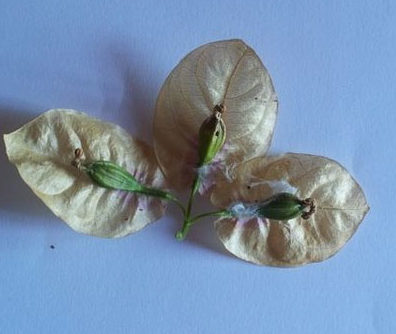
Bungewillia Seed Box
Seeds should be sown from late February to mid-April. First of all, you should prepare a loose nutrient substrate from leafy soil, peat and sand in equal proportions (you can use ready-made soil for flower seedlings), and a container with a lid. Before planting, we recommend soaking the seeds for several hours in a solution of some biostimulant.
Spread the seeds about 5 mm deep into a moist substrate two to three cm apart. Close the container lid. For better germination, keep the room temperature around 26g.The bottom heating will not be superfluous - it is optimal for the soil to be warm all the time, about 30 grams. Seedlings should be periodically sprayed with warm, settled water and ventilated.
Good lighting is also needed. In winter, it is necessary to supplement the greenhouse with sprouts with fluorescent lamps or phytolamps. Seedlings should appear in 2 - 3 months. It's time to open the container lid. Densely sown specimens dive into cups in the presence of 2 - 3 leaves. Grown bougainvillea specimens are transferred from cups into small pots with drainage and suitable soil for adult plants. They put it in a permanent place and grow further according to all the rules.
Liana Bougainvillea: botanical description
Bougainvillea (Bougainvillea, Bougainvillea) is a genus of perennial flowering plants of the Niktaginaceae family, a liana that grows mainly in South America. In places of its natural habitat, in countries when eternal summer reigns, it can bloom all year round, due to which it is widely used in landscape design. When grown in an apartment from October to March, it is at rest, but if you create conditions similar to natural conditions, it can bloom in December.
In fact, it owes its name to the French navigator Louis Antoine de Bougainville, who organized an expedition to South America in 1768. And this climbing shrub came to Europe thanks to a member of the expedition, botanist Philibert Commerson, who first discovered the plant and made a description of it. In total, 12 plant species were sent to France, but only two were widely distributed: Bougainvillea glabra or Bougainvillea glabra and Bougainvillea is wonderful. It was these species that became the parents of all modern hybrids.
Representatives of the Bougainvillea genus are climbing evergreen shrubs or short trees. In nature, they can reach heights of about 5 meters or more. Numerous sharp thorns grow on trunks and branches. The older the plant, the more thorns it has. The leaves are alternate, with a solid edge, dark green (or variegated), resembling lilac leaves in shape. The flowers are small, inconspicuous, tubular, brightly colored, most often purple or orange tones, collected in inflorescences of several pieces.
The ornamental value of the plant is determined by large bracts - covering leaves on the axis of the inflorescence, surrounding each true Bougainvillea flower from all sides. Another name for them is bractea from the Latin "bractea". Depending on the type of liana, they can be of different colors and shapes: they are heart-shaped, round, triangular, arrow-shaped. They reach 3-5 cm in length and, unlike real flowers, remain on the plant for a very long time.
Many are afraid to grow Bougainvillea in an apartment, doubting whether the tropical beauty is poisonous or not. There is nothing to fear. This vine is not a poisonous plant and is not only safe for humans and animals, but also has medicinal properties. In the countries where it grows, its flowers and leaves are often used in traditional medicine.
Reproduction of bougainvillea
This vine reproduces quite simply. This can be done with airy green cuttings or cuttings that have reached a certain degree of maturity. The most suitable breeding season is May - July.
How to root stem cuttings
Procedure:
- Cut the cuttings immediately below the kidney, and then treat the lower part with a special agent that stimulates the formation of roots (Kornevin, Epin or Zircon).
- Tear off all the lower leaves on the handle.
- Prepare the rooting medium for the cuttings. It should consist of sand and peat, taken in equal proportions. Pour the soil into a bowl and moisten.
- Bury the stalk in the soil mixture up to the second internode. Cover the container with the planting material with a clear plastic lid, bag, or glass jar.
-
Place an impromptu greenhouse in a warm place with a temperature of about +25 degrees.
-
Open the cuttings and ventilate the greenhouse twice a day. As the top layer dries, water the soil and spray the cuttings with warm water. After about a month, the cuttings will take root, and after a week they can be transplanted to a permanent place.
Master class on propagation by air layers
- Choose a well-developed, but not yet lignified shoot on the plant.
- Make small cuts on it.
- Press these places firmly to the ground and secure with wire or hairpin.
- Moisten the primer as usual. After two to three weeks, roots will appear on the layer.
- When it is well rooted, separate the new plant from the mother bush and plant in a permanent place.
How to grow indoor bougainvillea from seeds
Growing bougainvillea from seeds is fun, but a long process. In addition, the varietal qualities of the plant are not transferred with this propagation method. As a result, you can get a plant with a completely different color of the bracts.

In nature, bougainvillea seeds are spread by butterflies and hummingbirds.
Progress:
- Soak bougainvillea seeds in Epin's solution (growth stimulant) for 2-3 hours.
- Spread them over the surface of the soil, press lightly and moisten with a spray bottle.
- Cover the seed bowl with a transparent bag and place it on the radiator.
- Moisturize plantings daily, ventilate the greenhouse and wipe off condensation that accumulates on the bag. Be patient, seedlings will appear only after 2-3 months.
- As soon as the first true leaves appear, the bag can be removed and the seedlings can be looked after as usual.
- About six months after planting the seeds, the plants can be planted in separate pots.
Species diversity
It does not differ in an extensive list:
Bougainvillea glabra
This plant, five meters high, has bracts of various colors. They can be white, yellow, purple, pink, or red. The thorns of this variety are not very large. Naked bougainvillea is easily reshaped because cropping is not a problem for her. The year 1850 was the period when Jacques Denis Choise, a Swiss botanist, described Bougainvillea glabra.
You can meet the plant in dry areas of Brazil. Usually it loves rocky hills in the presence of calcareous soil on their territory.

Wonderful bougainvillea (Bougainvillea spectabilis).
Fifteen meters in height is an impressive figure for a plant. The pink, red and purple bracts are large in size. With such parameters, the likeness of a liana can twine around the facades and walls of arbors due to the flexibility of the shoots and a large number of thorns.
- The flowering of the plant is April-December.
- The birthplace of the Wonderful Bougainvillea is the Brazilian rainforest.

Peruvian bougainvillea (Bougainvillea peruviana).
Humboldt, a naturalist from Germany, discovered this variety for gardeners in 1810. In a climbing plant, yellow flowers are framed by purple and pink rounded bracts. Peruvian bougainvillea has short thorns and slender ovoid leaves. Lateral shoots do not appear in this variety, therefore the variety is considered stable in terms of plant pruning.
Colombia and Peru are the birthplace of Bougainvillea peruviana.

Three species were subsequently cultivated and breeders developed the following varieties:
- Australian Gold. A shrub with double bracts changes over time. Their original color changes from bright orange to pink. In some cases, burgundy spots appear on large oval sheets.
- California Gold. The plant is interesting because it often confuses the flowering time and "transfers" it to the winter. It has golden bracts at the ends, which is why it got that name. Over time, this golden bloom fades and turns into a beige shade.
- Double Lilarose.Flame-like bracts are the main characteristic of the spectacular variety. They will delight the eyes of a lover of all beauty for a long time, if you do not overdo it with watering.
- Double Red. This variety is valuable because its purple-raspberry color does not lose brightness during the entire flowering.
- White Cascade. Bracts of this variety are beautiful and resemble ivory in tonality. Some of them may have pink edging.
- Beggum Sikkander. It is a houseplant with light green leaves. The bracts are double-colored. The most popular combination in them is a white core and a purple frame.

Description of the flower
Bougainvillea belongs to the family of Nicholas or Niktaginovs. In its homeland, in South America, Bougainvillea is found everywhere in the form of flowering shrubs or trees with flexible branches creeping, climbing and clinging to everything - vines. Their shoots are covered with rare, but sharp spines, with the help of which the plant clings to the supports and stretches upward. The breeders have not yet been able to remove the thorns of home varieties of Bougainvillea. Shoots grow very quickly, reaching a length of five or more meters. At home, with good maintenance, the bush can also grow up to three meters in height. Its growth is held back by regular pruning.
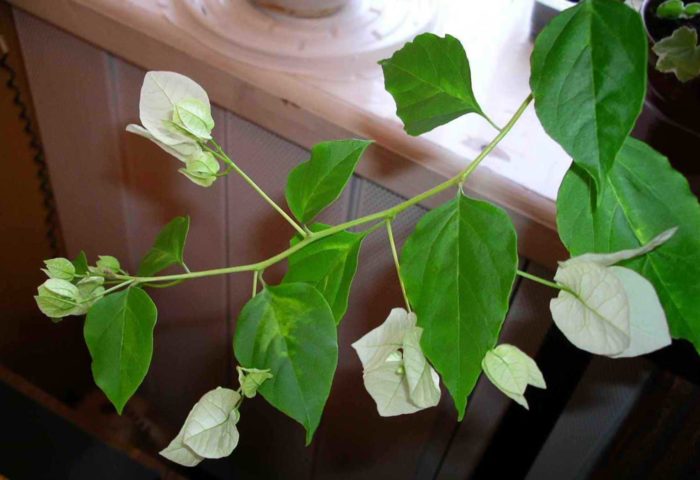
Bougainvillea Leaves
The leaves are bright green on the outside, and light green on the inside. Sometimes variegated specimens are found. The edge of the leaf is smooth and even, the tip is pointed. The leaves are oval or ovoid in shape, small in size. Sometimes smooth, sometimes pubescent (depending on the type of Bougainvillea). The leaves are arranged on the stems alternately.
Bougainvillea's flowers are tubular, inconspicuous, white-yellow, collected in racemose inflorescences. They quickly wither and fall off. But the bracts are striking in their magnificence. To the touch, they look like the thinnest crumpled paper. The bracts are brightly colored, brightly, in all shades of red, crimson, white, orange, purple and other colors. And in their shape, the bracts are no less amazing. They are round, arrow-shaped, heart-shaped, and even triangular. In length, they reach 3 - 5 cm. Unlike flowers, bracts remain on the plant for a very long time.
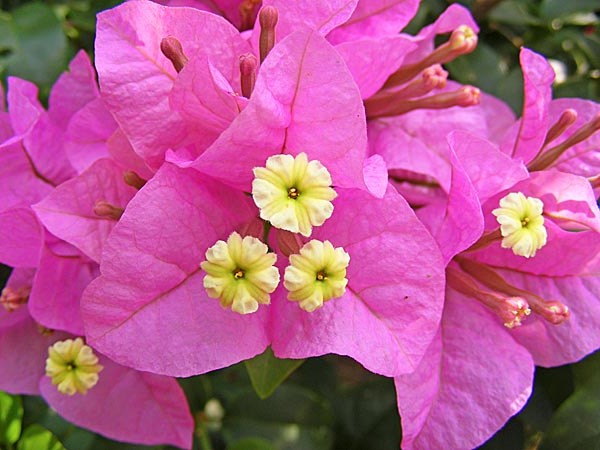
Bougainvillea flowers and bracts close up
In Brazil and countries with a similar, subtropical climate, where winters are mild and the air temperature does not drop below five degrees, Bougainvillea blooms all year round. This, and its extraordinary decorativeness, has gained immense popularity. It is grown everywhere - in gardens, squares, parks, decorates the territory of private households and tourist hotels, and is used in landscape design.
In our latitudes, Bougainvillea is grown by pruning in the form of a shrub, liana or bonsai tree in indoor rooms or greenhouses, and only in the summer is taken out into the garden. It blooms with us from May to November. Under comfortable conditions during flowering, the green leaves of Bougainvillea hide under the bright multi-colored caps of its stipules. The life expectancy of a home Bougainvillea does not exceed five to ten years. The flower does not die, it just stops growing and gradually lignifies. It is known that in greenhouses, some specimens of Bougainvillea live up to 30 years.
Bougainvillea: where it grows in Russia
Bougainvillea roots have a very low frost resistance, a drop in temperature below +5 ° C is destructive for them. Therefore, the plant is not able to survive in the harsh climate of our homeland. In the open field in Russia, it is grown only on the Black Sea coast of the Crimea and in the Caucasus. And even in these regions, the obligatory shelter of the plant for the winter is recommended.
In central Russia and the Urals, such a heat-loving plant can only be grown in greenhouse conditions, as a tub culture or, with proper care and maintenance, in an apartment.Among other things, bougainvillea is often used as a bonsai plant.
Diseases
Bougainvillea, although a tropical sissy, is resistant to diseases. Only severe violations of its content can break her immunity.
If Bougainvillea's leaves fall off in preparation for hibernation, this is a natural process. At other times, this may be caused by stressful situations: they put the pot in a draft, moved it to another place, or simply turned it over with the other side to the sun.
When buying a flowering healthy plant, at home you watch with chagrin as it begins to shed both leaves and bracts. Don't worry, this is Bougainvillea's reaction to moving from the store to your home. If you take care of the flower according to all the rules recommended by us above, it will soon become overgrown with green leaves and will thank you with lush flowering.
The same problem can arise after the end of the summer season in the garden, with the return of Bougainvillea to the apartment. Even a rearrangement from one window sill to another, poorly illuminated by the sun, can provoke a flower to drop leaves.
If the leaves have lost their bright color, it is possible that Bougainvillea has developed chlorosis. This happens when there is not enough iron and other nutrients in the soil. It is necessary to feed and spray the flower with iron chelate.
If the plant has leaves with soft white spots, then you have poor ventilation and an excessively damp substrate. Provide ventilation and water sparingly. Remove damaged leaves.
If Bougainvillea's leaves begin to turn yellow and fall off, most likely you are watering the plant too abundantly, the soil turns sour, and the roots lack oxygen. This happens most often in the winter. Reduce watering, stop spraying the flower, and stop feeding. Let him stop vital activity for a while - he does not eat, does not drink, only sleeps.
If the flower has lost its turgor, spray it with a growth stimulant, cover it with a plastic bag and leave it in a diffused shade for two to three days, periodically airing this greenhouse. The turgor should recover.
If the flower has stopped growing, then its pot is too cramped, the roots have nowhere to grow and develop. Bougainvillea's growth slows down and stops altogether until you transplant it into another, more spacious pot. A plant that is too old, which is more than 10 years old, also stops growing. It becomes woody and stops blooming. Take care of its reproduction in time.
When a plant disappears due to rotting of the root system, it must be rescued. Remove the bush from the pot, carefully free its roots from the substrate. If necessary, soak them in a bowl of warm water for this. Cut off damaged and rotten roots, keep healthy ones in a phytosporin solution. Then treat all sections with crushed charcoal or wood ash. Transplant the treated plant into a new substrate and strictly follow the rules for its maintenance in the future. Also treat the crown with a solution of phytosporin.
Pruning and replanting
The best time for pruning is the end of February or the beginning of March, and if the wintering is planned to be cool, you can make a "haircut" in the autumn. This is a necessary procedure, without which the plant branches too much and, as a result, loses its attractive and neat appearance.

First, you need to inspect and remove dry or wilted shoots. Healthy ones can be shortened by a third of the length, but be sure to step back a couple of centimeters from the leaf or bud. In order for the tree not to grow very high in height, pinch its tops a little.

For planting, choose medium-sized pots from one and a half liters to five. Young are transplanted every year, slightly increasing the capacity.

Starting from three years, replacement is made every 2-3 years. You need to take the container based on the further formation of the bush. If a bonsai is planned, then a wide tub is chosen, and the cascade looks better in a tall pot.







Care features
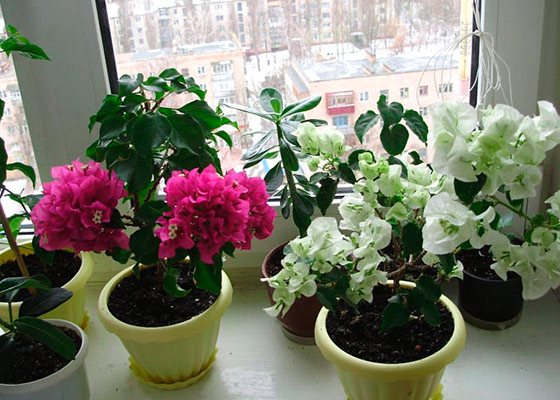
Bougainvillea loves bright lighting, without which it simply will not endow you with the beauty of its flowers. At the same time, direct sunlight is contraindicated for her. Place the pot with this flower not on the windowsill, but on a stand next to the window.
In winter, light the bougainvillea with an additional lamp. In summer, she feels great outdoors. Many growers at this time put pots with this plant directly on flower beds.
By the way, this flower does not like frequent movements. In this case, it can stop flowering for many months. The same can happen if you decide to twine bougainvillea branches around the support.
Olga Danilina
Planting and transplanting
Bougainvillea negatively transfers movement not only from place to place, but also a transplant. The plant adapts for a long time after replacing the pot, does not want to bloom, dries the leaves. Therefore, a tropical beauty is transplanted when it is impossible otherwise: the roots stick out of the drainage holes, growth has stopped due to depletion of the soil. Then wait for spring and relocate it. In fact, this will not be a transplant, but a transshipment with the maximum preservation of the earthen clod.
The new bougainvillea container should be 2–3 cm larger than the previous one. She doesn't need a voluminous pot. If there is a lot of soil, it will begin to build up the root mass, then the greenery, and the flowering will be delayed. In addition, moisture often stagnates in a large container, and this threatens with root rot. The material the pot is made of doesn't really matter. But it is better to plant a tall bougainvillea in ceramic, it is heavier and will be more stable. But the presence and size of the drainage holes are important. Excess moisture should not remain in the ground.
Bougainvillea soil will like loose and moderately nutritious, with a neutral acidity level. You can plant it in the soil for flowering plants by adding coarse sand or chopped moss. Or compose the substrate yourself:
- leafy and sod land, coarse sand - all equally, add a little vermiculite or brick chips for looseness;
- 1 part of leaf and sod land, 0.5 each of coarse sand and humus;
- 2 shares of any flower substrate, 1 each - vermiculite and soil for cacti;
- turf soil, peat, humus and sand in equal parts, add coal chips;
- two parts of leaf and peat land, plus one part of sod land and sand.
Make the drainage layer from expanded clay, small pebbles, broken red brick or crushed foam. The larger the pot, the more drainage in the pot.
We transplant a tropical vine
Prepare the pot, soil and drainage, sterilize everything.
We put a drainage layer on the bottom of the pot, on top - a little soil substrate.
Do not water the bougainvillea the day before, so that the earthy ball dries up a little, so it is easier to get the plant out of the old pot.
We carefully remove the flower from the old container, examine the roots. Remove the rotten ones
Carefully free several outer roots from the soil.
We install bougainvillea in a new pot, straighten the freed roots.
For better adaptation in a new pot, the roots can be sprayed with a stimulant (Epin, Zircon).
Slowly, we fill the space between the earthen lump and the walls of the pot, shaking it.
We compact the soil with our fingers, being careful not to damage the roots.
Water the tree abundantly and spray its crown. Humid air will help you adapt faster.
We put the transplanted bougainvillea in a permanent place (always sunny)
But for about a week or, if necessary, we shade it longer.
When the plant has settled down, we take care of it as usual.
Flower from the store
You brought the purchased bougainvillea home, do not rush to put it with the rest of the plants, but keep it in quarantine for two weeks. Give her a bright spot. Sprinkle with warm (+35) water. Let the bougainvillea get used to the new home.
- After about 10 days, stop watering to dry out the soil.
- Remove the plant from the pot.
- Remove the foil or bedding container, if present.
- Shake the substrate off the roots.
- Transplant the bougainvillea into fresh soil, preferably a foam drainage layer.
- Do not deepen the root collar.

